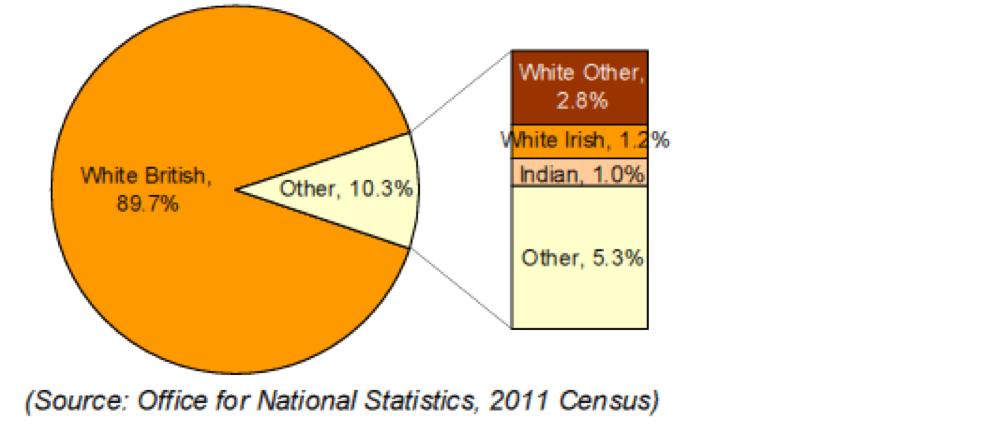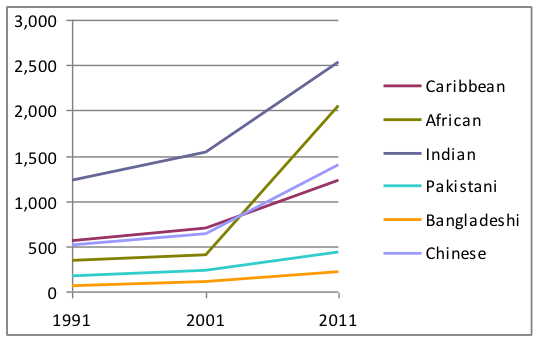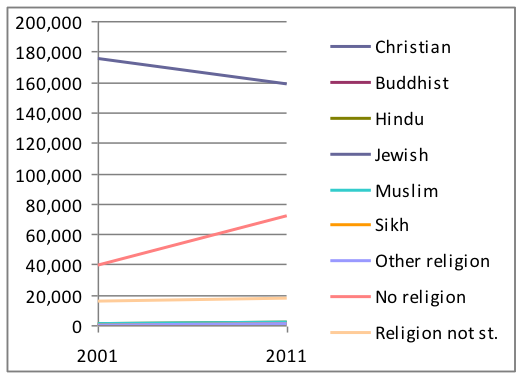Demographics
Central Bedfordshire is a unitary authority serving a growing population of around 294,100 in 2020. It is a largely rural area with over half the population living in the countryside and the rest in a number of market towns. The largest of these are Leighton Linslade, Dunstable, Biggleswade, Houghton Regis, Flitwick, Sandy, and Ampthill.
The area is generally prosperous, with above average levels of employment. This could mask the few areas where we do have pockets of deprivation and greater need (some households in Dunstable and Houghton Regis, for example).
The area has excellent transport links with the A1 and M1 running through it, three main rail lines, and two international airports, Luton and Stansted, on the doorstep. It is in the centre of an academic ‘golden triangle’ between Oxford, Cambridge, and London Universities and also benefits from its own academic institutions at Cranfield University, the University of Bedfordshire, and other further education colleges.
It is a great place to live and work. It is a relatively safe, green, and affluent area that attracts major investment. People living in Central Bedfordshire earn more than the national average; this is in part influenced by some residents commuting out of the area – primarily to Hertfordshire, Luton, London, Milton Keynes, and Bedford.
The Equality Act 2010 protects people from discrimination and harassment based on ‘protected characteristics.’ The following section considers these protected characteristics as they relate to Central Bedfordshire and some additional factors which impact life chances.
Protected characteristic: age
In 2020, 58,800 people in Central Bedfordshire were aged between 0 and 15. A further 182,700 were aged 16 to 64, with 52,600 aged 65 and over – this figure includes 6,500 people aged 85 and over. The number of people aged 65 and over is expected to increase by 40% between 2020 and 2035.
Protected characteristic: disability
An individual has a disability if they have a physical or mental impairment which has a long-term and substantial adverse effect on their ability to carry out normal day-to-day activities. Physical or mental impairment includes sensory impairments such as those affecting sight or hearing.
Using the widest definition, there are more than 11 million disabled people in the UK, that’s more than one in five of the adult population and one in 20 children. 80% of people experience a year of being disabled at some point in their lives and 66% of disabled people develop impairments during working age. The majority of disabled people have impairments that are not easily visible. In the 2011 census findings, 15,465 (6.1%) residents in Central Bedfordshire indicated that day-to-day activities were limited a lot, and 21,142 (8.3%) residents indicated that day-to-day activities were limited a little.
Protected characteristic: gender reassignment
People who are proposing to undergo, are undergoing, or have undergone a process (or part of a process) to reassign their sex by changing physiological or other attributes of sex are protected from discrimination.
The 2011 Census did not include a specific question in respect of gender reassignment. It is estimated from national research that 1 in 10,000 people experience the recognised medical condition known as gender dysphoria, generally referred to as being transgender or transsexual. In any school of 1,000 pupils, there are likely to be six who will identify as transgender.
Protected characteristic: marriage and civil partnership
In 2011, 52.5% of the Central Bedfordshire population (aged 16 or over) were married and 0.1% had entered into a civil partnership. 29.2% of the population were single, 11.9% were separated or divorced, and 6.3% were widowed.
Protected characteristic: pregnancy and maternity
This protects women from discrimination because of their pregnancy and maternity. The health and wellbeing of women before, during, and after pregnancy is an important factor in giving children a healthy start in life and laying the groundwork for good health and wellbeing in later life. Under 18 conceptions are lower in Central Bedfordshire than the national average and statistical neighbours. However, there are areas where under 18 conceptions are significantly higher than both the national and local authority rates. Children and young people who are already disadvantaged have an increased risk of teenage pregnancy. Therefore, targeted interventions aim to reduce the risk factors by tackling the underlying causes.
Protected characteristic: race
Includes dimensions such as colour, nationality, and ethnic or national origins. There are two essential characteristics that an ethnic group must have: a long shared history and a cultural tradition of its own. In addition, an ethnic group may have one or more of the following characteristics: a common language; a common literature; a common religion or common geographical origin; or being a minority or an oppressed group.
Central Bedfordshire is ethnically diverse, with around 10.3% of people living in the area from black or ethnic minority communities. The biggest ethnic minority groups in Central Bedfordshire were White Other (not White British, White Irish, or Gypsy or Irish Traveller), White Irish, and Indian.

0.8% of the population are Black African and 0.6% of the population are Chinese. Gypsies and Travellers account for 0.2% of the population, which is slightly above the England and Wales average of 0.1%.
Changes in ethnic groups other than white during 1991, 2001, and 2011

Source: Centre on Dynamics of Ethnicity
Protected characteristic: religion and belief
Religion means any religion and includes a lack of religion. The term ‘religion’ includes the more commonly recognised religions in the UK, such as the Baha’i faith, Buddhism, Christianity, Hinduism, Islam, Jainism, Judaism, Rastafarianism, Sikhism, and Zoroastrianism. A religion need not be mainstream or well known to gain protection as a religion. However, it must have a clear structure and belief system. Denominations or sects within religions, such as Methodists within Christianity or Sunnis within Islam, may be considered a religion for the purposes of the act.
Belief means any religious or philosophical belief and includes a lack of belief. A belief which is not a religious belief may be a philosophical belief. Examples of philosophical beliefs include Humanism and Atheism. A belief need not include faith or worship of a god or gods, but must affect how a person lives their life or perceives the world.
Most of the population state their religion as Christian (62.2%), with (28.4%) having no religion, and other religions constituting (2.6%) of the population (note: 6.8% did not state their religion).
Changes in religion and belief during 2001 to 2011

Source: Centre on Dynamics of Ethnicity
Protected characteristic: sex
Refers to a male or a female of any age. The sex ratios of the Central Bedfordshire population vary according to age. In 2020, the younger age groups (ages 0 to 17) comprised 51% boys and 49% girls. Working age adults (ages 18 to 64) comprised 49% men and 51% women, while among older people (aged 65 and over), 53% of the population were women, and 47% men.
Protected characteristic: sexual orientation
Relates to how people feel as well as their actions in terms of their sexual orientation towards:
- persons of the same sex (that is, the person is a gay man or a lesbian)
- persons of the opposite sex (that is, the person is heterosexual)
- persons of either sex (that is, the person is bisexual)
The 2011 Census did not include a specific question in respect of sexual orientation. It is estimated that ‘out’ gay people living in the United Kingdom form between 6% to 10% of the population. This means that in Central Bedfordshire approximately 20,000 people are likely to openly be lesbian, gay or bisexual, with others feeling unable to disclose such information because they fear the reactions of people around them. The 2011 Census showed that there were 300 civil partnership couples in Central Bedfordshire. More recent data showed an average of 13 new civil partnerships each year between 2010 and 2014.
Additional factors which impact on life chances
There are four key areas in which equality gaps are most likely to produce further waves of inequality for particular groups of people. They are early years and education, employment, health, and criminal justice. The Equalities Review 2007 identified three types of extreme, chronic, and persistent inequalities:
- different groups of people experience different outcomes in common aspects of life, such as education or employment
- different needs may mean that we have to enjoy different treatment from others in order to gain a more equal outcome – most clearly in the area of healthcare
- circumstances which could apply to anyone, but which disproportionately tend to afflict some groups; and which can trigger substantially divergent outcomes in life chances
Skill level
The proportion of working-age people with at least NVQ1 or 2 qualifications (1 GCSE or similar) in Central Bedfordshire (74.0%) is similar to the England figure (73.2%). The proportion with NVQ4 or above (degree or similar) level in Central Bedfordshire (35.1%) is also comparable with the figures for England (35.7%). 6.1% of Central Bedfordshire’s working-age population had no formal qualifications, slightly less than the England figure of 8.6%.
Employment
In 2014, 82% of Central Bedfordshire residents aged 16-64 were in employment, compared to 73% in England.
Health
In 2011, 125,000 (49%) of residents reported that they were in very good health, 90,400 (35.5%) reported that they were in good health, 29,200 (11.5%) reported fair health, 7,700 (3%) reported bad health and 2,100 (0.8%) reported very bad health. Overall health is better than the UK norm.
Deprivation
No part of Central Bedfordshire is in the 10% most deprived areas nationally, but three small areas, in Downside, Parkside and Flitwick, are in the 10% to 20% most deprived in England. While Central Bedfordshire has relatively low levels of deprivation overall, these areas face particular challenges relative to the rest of the area. In addition, there are a number of communities (including the areas noted above) with specific issues, that appear in the 10% most deprived nationally when specific aspects of deprivation are considered such as crime, education, skills and training, income, and barriers to housing and services.
Carers
Research undertaken by Carers UK indicates that over 2 million people become carers every year and 3 in 5 people will become a carer at some point in their lives. In the 2011 Census findings, 18,247 (7.2%) residents in Central Bedfordshire indicated that they provided between 1 to 19 hours a week of unpaid care. A further 2,702 (1.1%) of residents indicated that they provided 20 to 49 hours of unpaid care a week and 4,886 (1.9%) residents indicated that they provided 50 hours or more unpaid care a week.